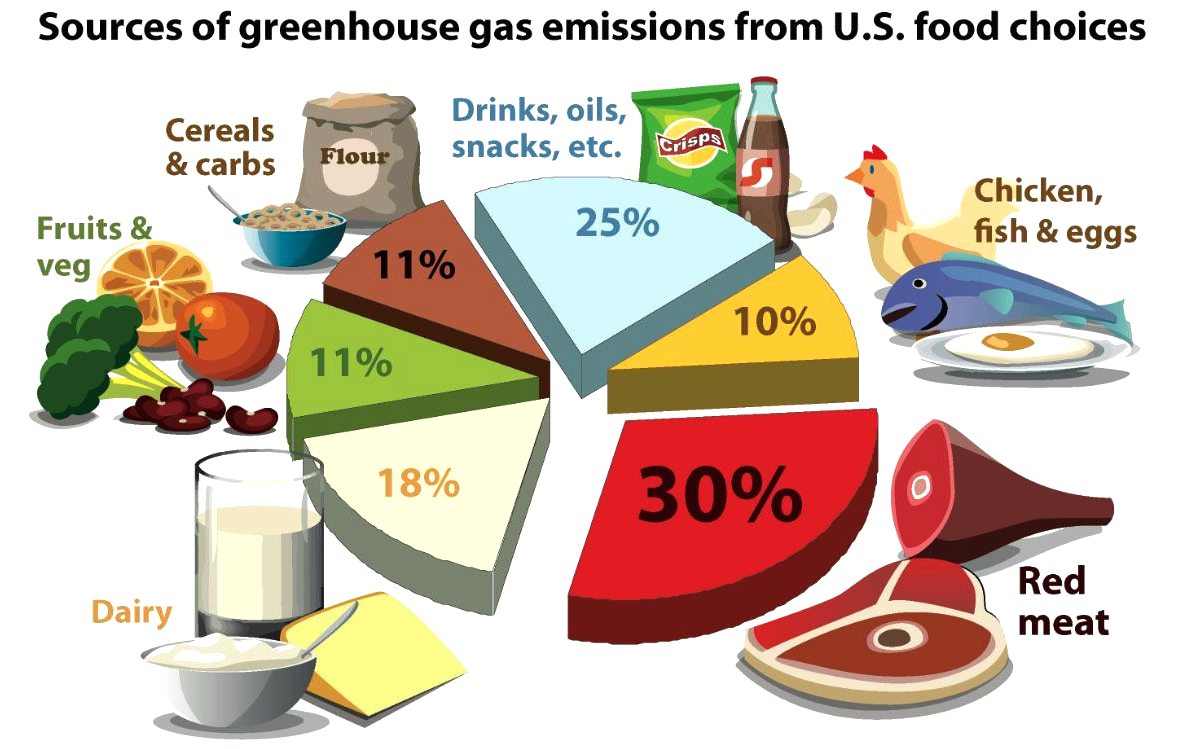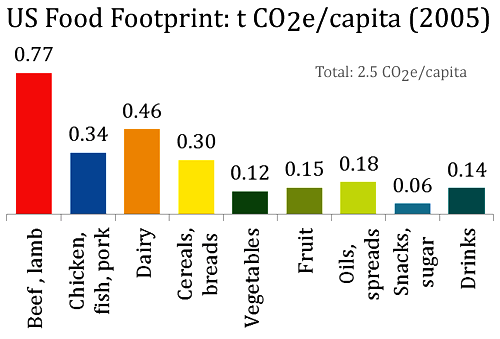|

Q.
How big is your food footprint?
Not all foods are equal.
Food Carbon Footprint Calculators (FCFC) provide the opportunity to calculate the resultant carbon dioxide from the food you eat, called your "Food Carbon Footprint".
This website offers practical ways to reduce the carbon footprint of your diet, reducing your impact on climate change.
The food footprint estimates and measures:
1. Land used for food production. This is both the land used for growing vegetables, cereals, etc. for human consumption, as well as grassland & other crops used to providing animal feed. (land footprint)
3. Land needed to absorb the carbon dioxide emissions given off while burning
fossil fuels. It is the area of forest ('sequestration land') that would be required to absorb the carbon dioxide emissions from energy consumption. (energy footprint)
3. Sea area required for fishing.


"Ecological footprints are measured in global hectares (gha) - the amount of bioproductive land and sea available on the planet. We can calculate our footprint by adding up the hectares it takes to grow our food and farm the animals we eat; the hectares our house stands on; the hectares that oil refineries and other energy infrastructure we depend on take up; the hectares of forest that would be needed to absorb the
CO2 emitted by our fuels; a share of the hectares taken up by our roads; and everything else we do that has an impact on the
planet’s ecology" WWF Definition.
"Ecological Footprint is a sustainability indicator that measures the total environmental pressure of the human population in spatial terms. It estimates the land and sea area that is needed to provide all the resources for a population in a given area, and for absorbing its emissions. The Footprint is calculated as a standardized area equivalent to a world average area, expressed in global hectares.

CLIMATE
CHANGE
- The food we consume contributes to climate
change. The production, packaging and transportation of food all consumes energy and results in carbon emissions which threaten to raise average global surface temperatures.
MEAT FREE MONDAYS - UNITED NATIONS
UNIVERSITY
Meat free Mondays has to be the way to go. Former Beatle Paul McCartney backs it. Rajendra Pachauri, head of the Intergovernmental Panel on
Climate
Change, advocates it.
But somehow the reaction you mostly get for proposing such a thing is criticism rather than praise. We love our meat. Our meat industry loves our meat. Our political leaders love our meat. You can’t expect people to turn vegetarian, even one day a week, simply because it might help save the planet.
Health ministers, like Ben Bradshaw from the UK, will step in and say that they don’t suspect meat consumption is a big contributor to
climate change. Or some will argue that there are more useful things you can do to reduce your carbon emissions than giving up meat. This seems to be the common comeback to most calls for personal action to reduce emissions. Save energy at home rather than flying. Or rather than giving up meat, give up flying instead. Always one cop out or another.
But where do we get the idea that meat eating is bad for the climate? It seems every one points to a 2006 report from the
United Nations
Food and Agriculture Organisation that found that the meat industry produces more greenhouse gases than all the SUVs, cars, trucks, planes, and ships in the world combined.
The report, entitled Livestock’s Long Shadow, claimed that meat production accounts for about 18% of the world’s total greenhouse gas emissions (download the report from the sidebar above to learn more).
Perhaps one way to respond is to try to clean up the meat industry and find ways to reduce the associated emissions directly from the ‘sources’ mouths’ (changing feeding practices to reduce methane emissions from cattle). That would be very nice, because it means I don’t have to do anything at all.
But then again, maybe it is also about you and I making different decisions about how much meat we should eat. We could begin by following Meatless Mondays and gradually reducing the amount of meat we eat until we become
vegetarian.
What do you think? Have you stopped eating meat? Have you reduced your meat consumption? Or are you happy to carry on chomping those
burgers and steaks?
Please
consider changing from red meat to poultry, from poultry to fish
and from fish to vegetables
and grains, or you might go the whole hog and become a vegan.
YOUR
HEALTH MATTERS
Eating less meat reduces the risk of, and in many cases reverse, many diseases and health anomalies.
Eating less meat helps with more 50 different types of diseases, such as:
Cancer
Obesity
Early Puberty
Atherosclerosis
Diverticulosis
Appendicitis
Impotence
Skin rashes
Stroke
Epilepsy
Osteoporosis
Hypoglycaemia
Hiatal Hernia
Varicose veins
Hypertension
Heart disease
Dementia
Rapid aging
Gallstones
Arthritis, Gout and Rheumatism
Neuritis and Sciatica
Nose bleed
Irritable Colon Syndrome
Colic
Haemorrhoids
Multiple Sclerosis
Jaundice
Indigestion & belching
Kidney stones
Increased infant mortality
Blindness
Diabetes
Anaemia
Lack of energy
Liver disorders
Ulcers
Gangrene
Peritonitis
Gallbladder diseases
Kidney diseases
Constipation
Chest pains
Gallbladder inflammation
Gallbladder gangrene
Abdominal Pain
Bleeding
It is thus reasonable to assume that to achieve minimal risk of bad cholesterol and carcinogens in food, we should try to adopt a wholefood plant-based diet as often as possible, which includes a variety of whole grains, fruits, vegetables, legumes, nuts and seeds.

FRIENDS
OF THE EARTH - As schools across the nation grapple with how to feed kids healthier, more sustainable food on tight budgets, an inspiring story from Oakland Unified School District provides a roadmap for change. Friends of the Earth’s new case study shows how the district was able to significantly reduce its carbon and water footprint by replacing a share of its meat, poultry and cheese purchases with plant-based proteins. These actions also saved the district money and improved students’ access to healthful food.

BIOENERGY CROPS
- Unsustainable food systems can be improved in a biobased economy.
Many food systems could be more sustainable if we rotate annual crops with sustainable biomass perennial systems we can use for many purposes, including heat or power
A person’s food footprint (foodprint) is all the emissions that result from the production, transportation and storage of the food supplied to meet their consumption needs. We chose to focus on food supply, rather than only food consumption, because a large proportion of food is lost at retail and consumer level. Although emissions also occur when people transport, store and cook food, these emissions are omitted from our calculations as they are captured in travel and housing footprints.
A landmark scientific assessment commissioned by the United Nations Environment Programme (UNEP) has confirmed that
agriculture has a monumental impact on earth’s finite resources.

According to the study, 38% of the world’s total land area was used for agriculture in 2007 and agriculture is responsible for over 70% of global freshwater consumption.
Additionally food wastes can be used and bioenergy crops can be used to complement supply chains. See an example for biogas in the Caribbean.
Most alarming however, is the inefficiency of our food production system, encouraged by diet preferences in developed countries especially, but increasingly worldwide. Even in comparison to industrial activities, which are heavily criticized for their impacts on the atmosphere and biosphere, “agricultural processes have an inherently low efficiency of resource use, which renders food, fibres and fuels from agriculture among the more polluting resources”.

ECO
BUSINESS - 10 ways to reduce your plastic footprint. Plastic waste hit a new high recently, with experts predicting that soon there will be more plastic than
fish in the ocean. Travel firm Contiki offers 10 tips to reduce our plastic footprint.
The problem with an issue as huge as the global plastic epidemic, is where do you begin? The statistics around plastic pollution speak for themselves and are impossible to ignore – 500 billion plastic bags used annually, 5 trillion pieces of plastic floating in our oceans, one million
sea birds killed annually from plastic ingestion or entanglement.
One way of spreading the news about how to reduce your plastic
consumption is with an application for a mobile phone. We are doing the
same, producing a free
download for Android and iOS mobile devices.
HOW
CAN YOU HELP ?
If you are a corporation looking for ways to reduce your carbon
footprint, you may like to take a look at
how we adapted an old building to virtually eliminate heating energy
bills.
Carbon
literacy is one of the weapons in our armoury to combat climate
change. Our
awareness campaigns
are based on reason, seeking to define the facts and separate them from fiction and spin - to enable us to find common ground on which to build a society that can
comfortably support life on earth on firm ethical and moral terms. By supporting us our associates and partners are contributing to essential research that may guide corporations and policy makers as to what is promising and the appropriate remedies that could be available, made possible by our increasing knowledge of technology and the state and pace of development that is considered necessary to
halt global
warming.
IT'S
OUR FAULT AND OUR JOB TO PUT THINGS RIGHT
Without us and our ability to exploit nature using technology, there would be
no climate change. It is our fault that marine life is being
subjected to acid
oceans. It is our
fault that there are
giant
swirling masses of plastic in the Atlantic,
Indian
and Pacific
oceans.
These are problems that can be tackled and overcome if we all work
together. We must educate our brothers and sisters who do
not yet realise what they are doing. And we must try to help corporations
and governments who are wanting to alleviate these problems; to reduce their
carbon and plastic footprints.
Please
help us if you can.

CARBON
FOOTPRINT LTD - One way of spreading the news about how to reduce your
energy consumption is with an application for a mobile phone. We are doing the
same, producing a free
download for Android and iOS mobile devices. If electricity is responsible for roughly 37% of Carbon Dioxide
emissions, then fitting photovoltaic
panels to replace electricity use at home and in the factory could do
the planet a big favour.
LIGHTING - Fit LED bulbs and replacement lights wherever possible. They use at least 75% less energy and last up to 25 times longer. Compact fluorescents save more than 2/3rds the amount of energy of regular light bulbs.
COMPUTING - Use a laptop instead of a work station. Laptops, unlike desktop computers, are designed to be energy-efficient, because battery life is a major factor to laptop design. According to Energy Star, a laptop can be up to 80% more energy-efficient than a desktop. Energy-efficient LCD screens, hard drives, CPUs and adaptors all factor into making makes laptops much better tools for the planet.



LINKS
& REFERENCE
http://www.greenandhealthymonday.sg/learn/ http://greenmonday.org/environment/ https://foe.org/resources/shrinking-carbon-water-footprint-school-food/ https://ourworld.unu.edu/en/debate-2-0-meat-or-the-climate-pick-one https://ourworld.unu.edu/en/debate-2-0-meat-or-the-climate-pick-one http://bioenergycrops.com/blog/2014/06/02/5-best-reasons-reforest-biomass-for-renewable-energy/ http://sustainablefood.com/Foodfootprint-What.htm https://www.carbontrust.com/ https://www.carbonfootprint.com/ https://carbonfund.org/calculate-your-footprint/

|











